What are the dreaded two words that no one wants to see when trying to collect money for their service?
Payment failure. And it will inevitably happen sooner or later, that’s for sure.
Too many factors are at play here, many of them beyond your control. But the good news is that you can manage payment failure so that both you and your customer go through it unscathed.
In the following sections, we will cover six helpful tips on how to manage payment failures better, so let’s get right to it.
Jump to section:
Take Steps to Prevent Payment Failure
Retry the Payment Multiple Times
Properly Communicate the Payment Failure
Choose the Right Communication Channel
Create an Effective Call to Action
Automate Your Dunning Emails
Take Steps to Prevent Payment Failure
You can prevent many instances of payment failure just by being aware of what causes them in the first place.
Why even bother preventing payment failure? Well, imagine losing customer after customer because of something you could easily avoid, or at least mitigate.
You might think that losing a customer isn’t so bad; after all, you have an amazing service, and you will get another in no time!
However, the truth is that it can cost 25 times more to get a new customer than to keep one you have happy, as seen in this article from Harvard Business Review. That’s a lot by any criteria.
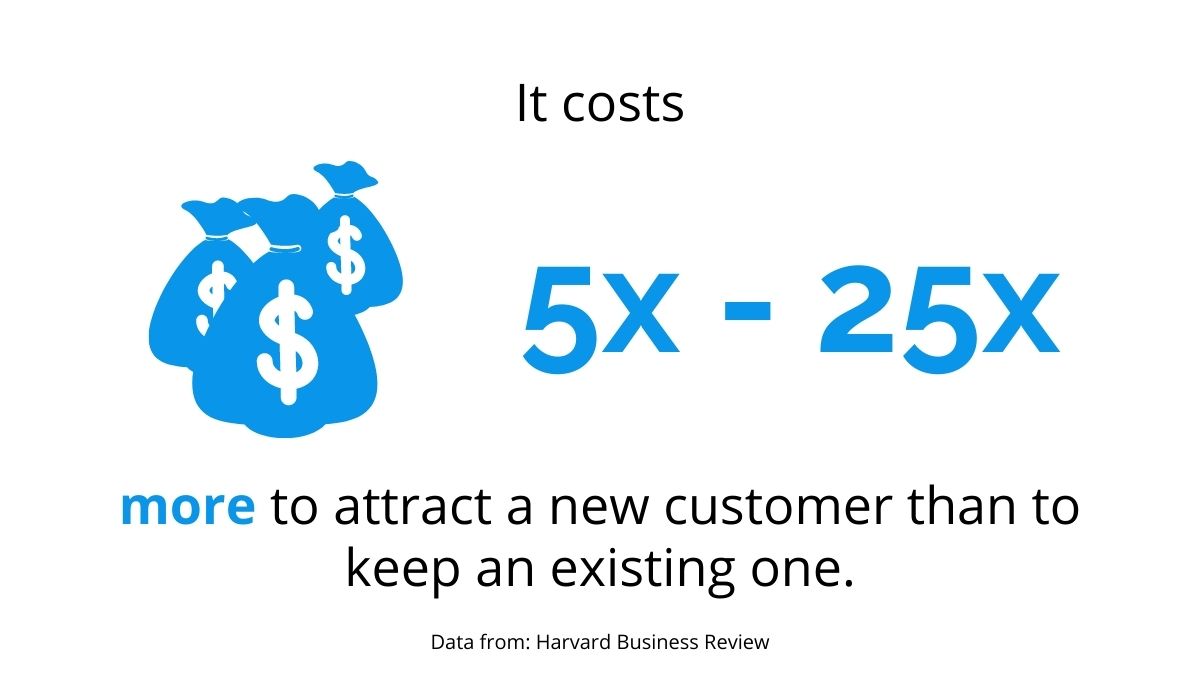
Source: Regpack
To drive this point home, the result from a Bain & Company study shows that just a 5% increase in customer retention yields a 25% to 95% increase in profit. So it’s safe to assume that it’s worth going out of your way to retain your customers.
Payment failure can occur because of something simple, like a customer having insufficient funds on their credit card or accidentally entering incorrect information, for example, the billing address.
But most often, the culprit is an expired card.
Credit cards typically expire every three years, meaning that this is a predictable event. Nevertheless, many customers just don’t keep the expiration dates of their cards in mind so it’s a good idea to send them a reminder of imminent payment failure.
You can do that by email. However, it’s important not to overwhelm the customer with too many emails, which could just make them simply ignore you, and justifiably so.
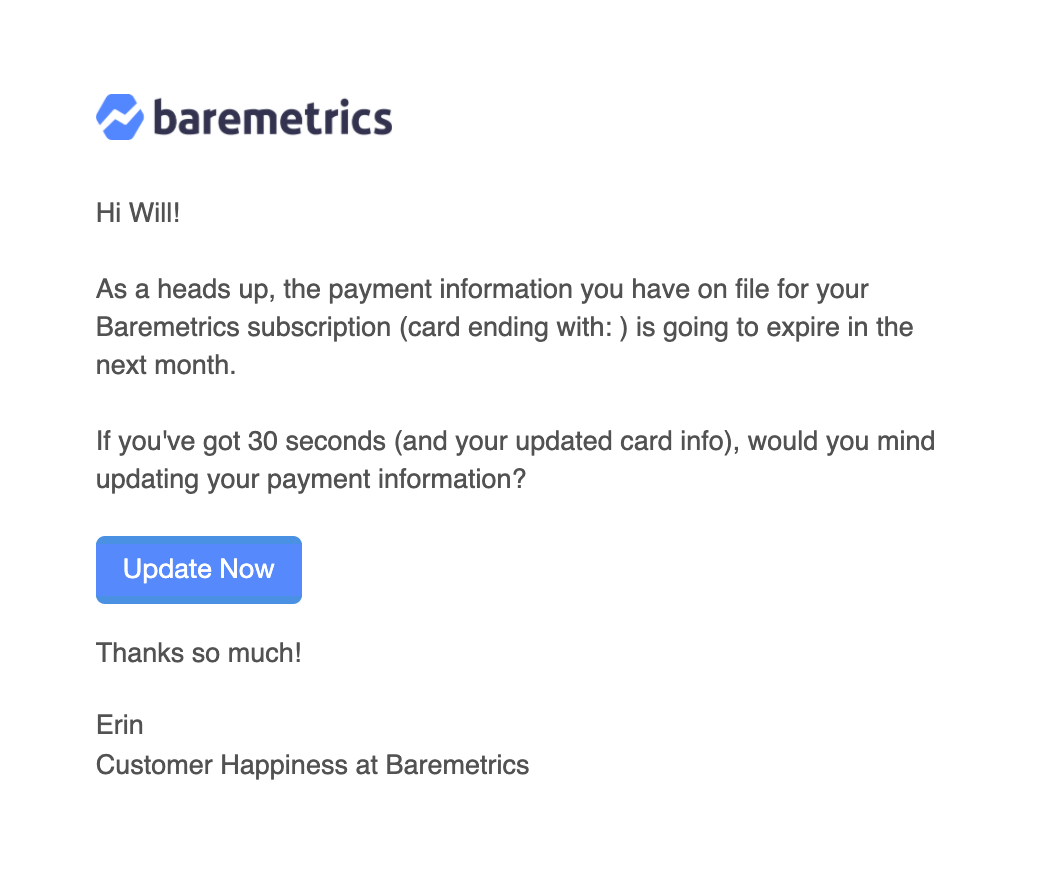
Source: Baremetrics
This example from Baremetrics was sent a month prior to card expiration. One notice like this should be enough, but you could send another one closer to the expiration date, for example, a week before card expiry.
Warning emails like this are also known as pre-dunning, and in today’s business practices, it is generally frowned upon to bother customers too much with them. We will cover how to compose and send them in the following sections.
One reason why it’s unnecessary to send multiple reminders is the automation of credit card updates.
For example, Visa has a system that interfaces with merchant accounts and updates credit card information, fixing a lot of problems in advance.
In fact, a lot of expiration dates (according to Churnbuster, as many as 70%) get updated without any action needed—if you have proper systems in place.
So, payment failures don’t even need to happen in many cases.
But, they still happen, and we will see how to proceed if we get that dreaded payment failure message from a customer in the following sections.
Retry the Payment Multiple Times
Sometimes payments fail for reasons other than credit card expiration, incorrect data or insufficient funds.
The cause can simply be a glitch in the system. In 2019, for example, Stripe, the financial services provider, suffered two outages in one day, resulting in more error messages, increased response time, and millions of clients who couldn’t manage payments.
Things like that can happen, so it is best not to send an enforcer with a baseball bat at the first sign of potential problems (in fact, please don’t do that, ever).
After all, you want to stay in your customers’ good graces and do what it takes to retain them, as we mentioned.
Spotify has a very laid-back approach to warning its customers of a payment failure; a short email that lets the customer know there has been a problem and that Spotify’s team will try again soon.
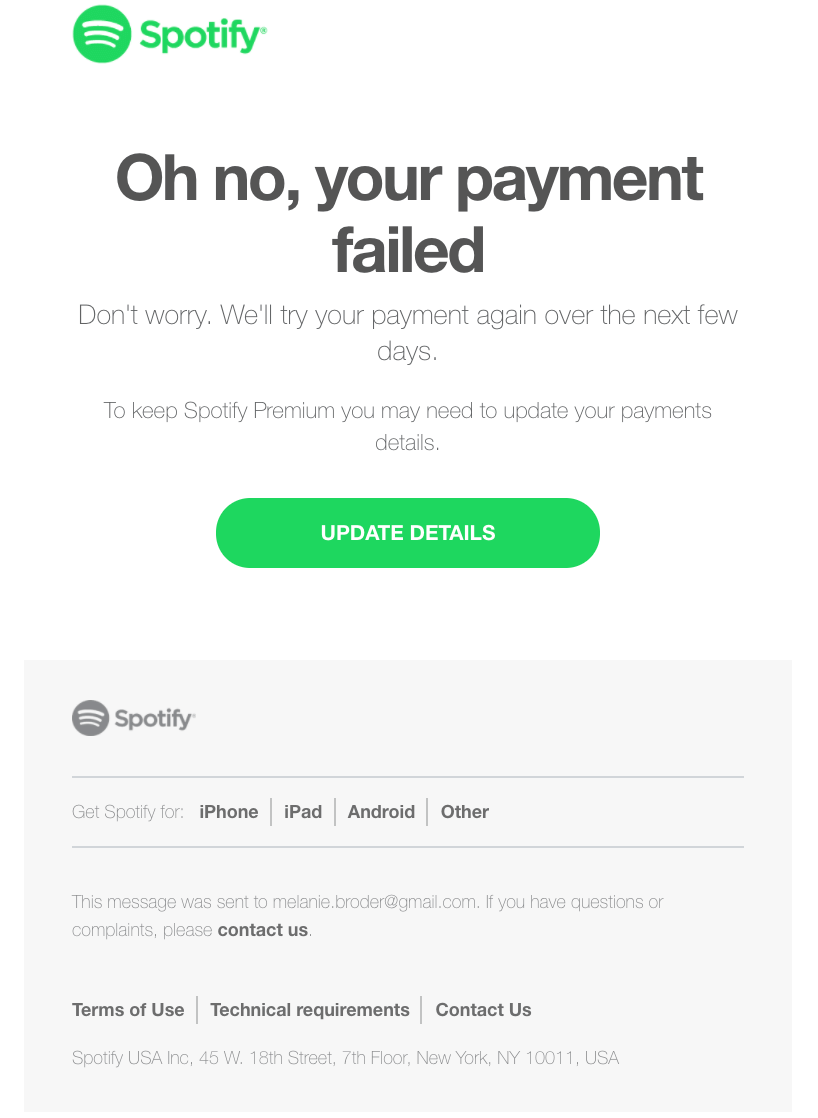
Source: customer.io
A message like that does what it is supposed to: establishes contact and informs, states what the following steps will be for the service and what the customer could do next (we will talk about that part later)—all while keeping it relaxed.
You can make some payments go through just by trying the same card again. That can work after a soft decline, which means that the bank approved the payment, but the failure happened during the process.
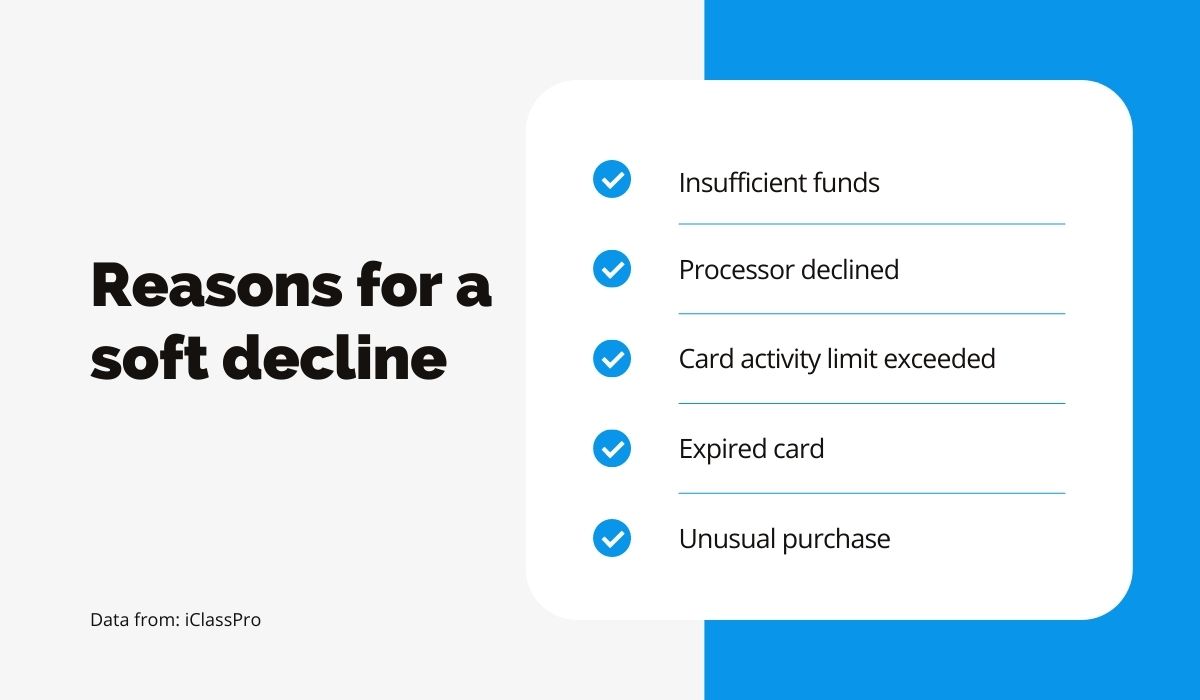
Source: Regpack
It is a good idea to retry the payment after failure a few times. For example, once a week over the following three weeks, with the first retry taking place a day or two after the payment failure.
However, if there is a hard decline, there is not much use in retrying.
A hard decline means that the bank has refused the payment due to a stolen or invalid card or even a closed account. With that type of decline, it’s up to the customer to fix the issue.
We established by now that some sort of communication between you and the customer is necessary in the event of payment failure.
How to properly discuss something delicate as payment failure? The following section will give you some pointers.
Properly Communicate the Payment Failure
The right approach to addressing payment failure is vital in preserving your relationship with the customer and making sure that payment eventually goes through.
In fact, according to research, maintaining a good relationship with a customer is by far the most important factor when it comes to the customer’s decision—should I stay or should I go?
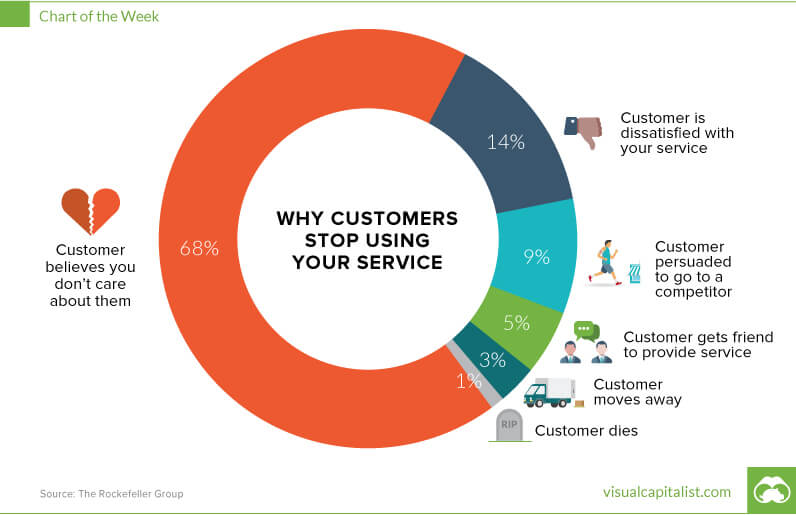
Source: visualcapitalist
Another good reason you should properly communicate a payment failure is that a service you are providing (and charging for) could be canceled without the customer even knowing, or worse, start accumulating late fees.
This could lead to some serious friction between you and your customer, so it’s best not to let it come to that.
When communicating the aforementioned issue with the customer, consider adopting a friendly, approachable tone.
You don’t want to make undue accusations or stir unwelcome feelings like fear or anxiety.
Remember that it is very likely that a customer is not trying to scam you and has no idea what is going on. Craft your message with that in mind; be gentle but straightforward and clear.
Furthermore, pay attention to every part of the dunning email: subject line, body and sender information.
If someone gets on average 121 emails a day and opens 21,3% of them, you better make your subject line one that stands out from the rest if you want to be in that number.
Try using your brand name in combination with strong, emotional words or phrases, like in this example:
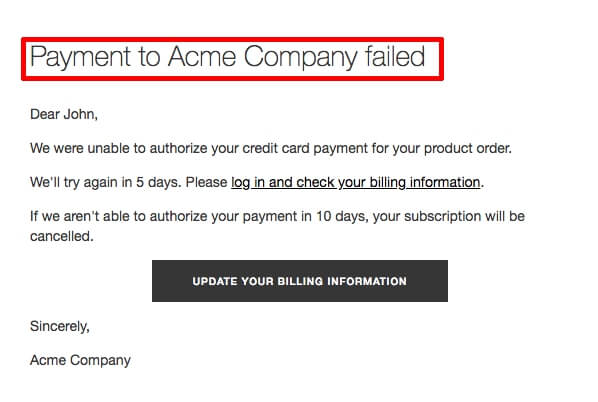
Source: SquareSpace
It is clear who the email is for, and the word failed attracts attention, both increasing the chance that the recipient will open it.
When the customer opens your email, it would be good if they saw a concise account of what happened and what to do. So, reign in your inner Tolstoy and keep it concise—something like this:
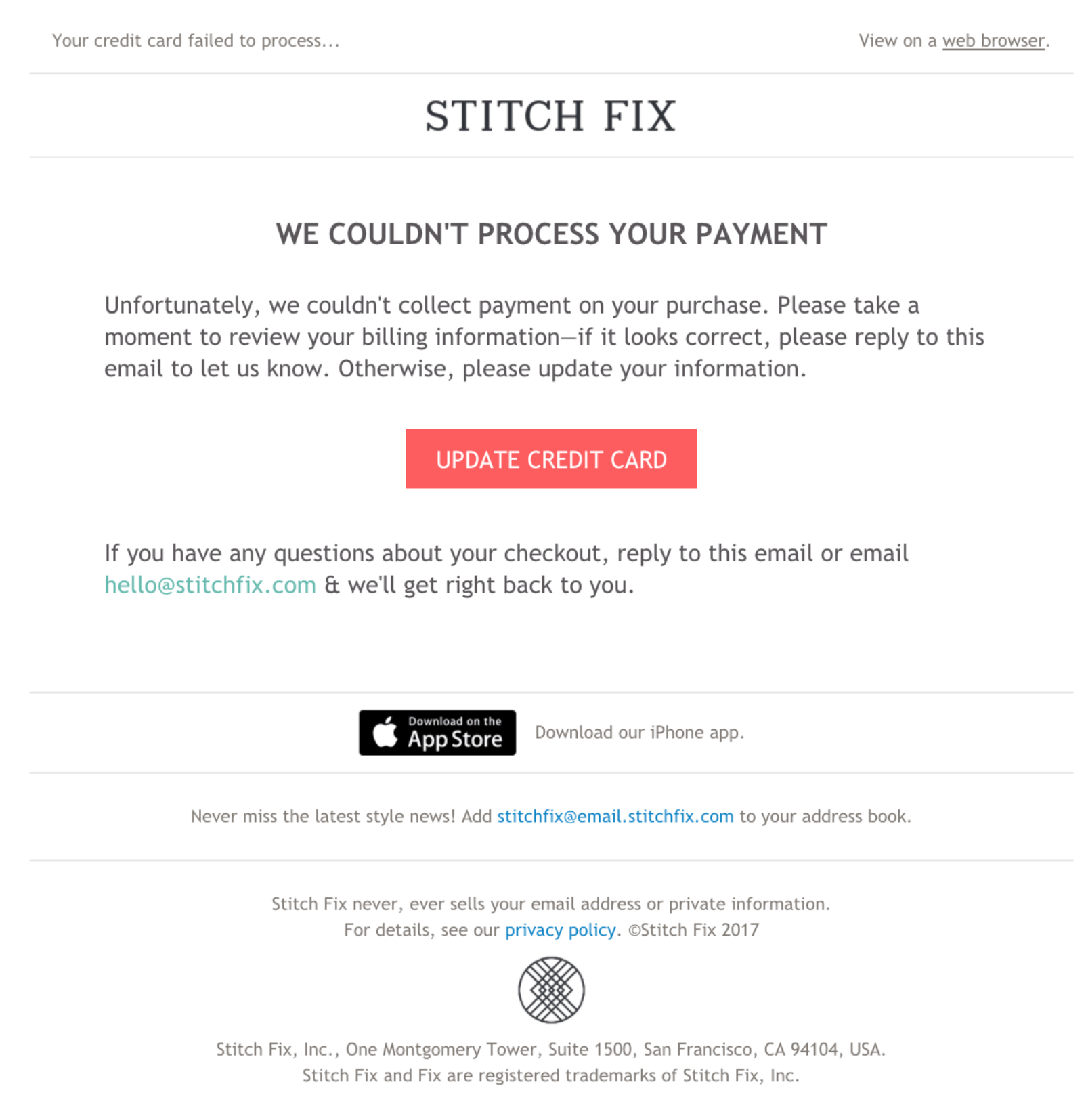
Source: customer.io
Every necessary detail is here in just a few lines of text—payment failed, review your information, contact us or update it. Simple, respectful and effective.
Regarding the sender, you can make it more personal by sending an email from a “name@company” address instead of a department address like “support@company” or “billing@company”.
That is up to preference, but be sure that it is clearly visible from the email address that your company is the sender.
Up to this point, we’ve only talked about dunning emails. But there are other channels you can use to get in touch with your customer, so let’s see what they are.
Choose the Right Communication Channel
Email is often a go-to option for communicating about payment failure, but that is exactly why you should consider other channels too.
As we’ve mentioned earlier, if most companies and organizations use email to communicate with their customers, there is less chance your email message will receive the attention you want it to receive.
So, contacting a customer via a less-used channel increases your chances of being heard.
Furthermore, according to data from a Gmail case study done by Smart Insights, not even half of brand emails land in the inbox—most of them go in the promotions tab, and a few percent in the folder where emails go to die, spam.
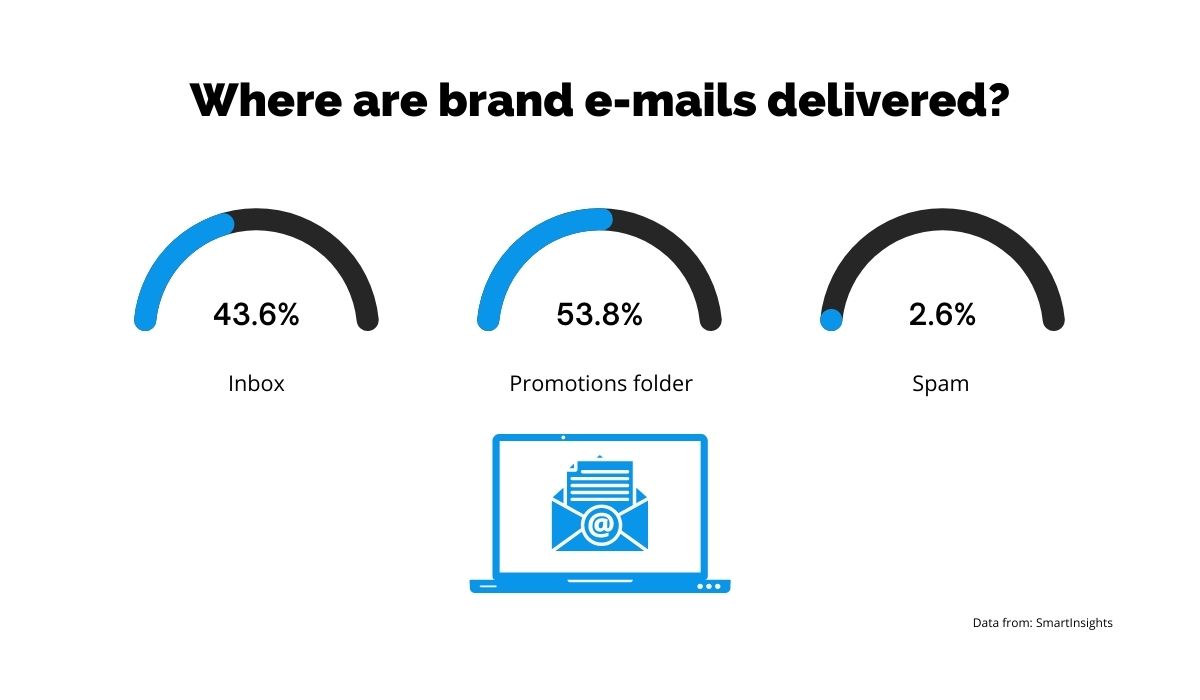
Source: Regpack
On the other hand, we have some interesting numbers. According to BankMyCell, 6.64 billion (yes, that’s a billion with a b) people worldwide are smartphone users. That’s almost 84% of the world population.
There’s more: when we add regular phones, it amounts to 7.26 billion total mobile phone users globally, or 91.69% of people.
And you know what all mobile phones can receive and what gets read in 98% of cases? A good old text message.
Yes, an SMS can be a perfectly suited communication channel for payment failure messages, especially if you consider data collected by Campaign Monitor, which found that the average opening rate of emails across various industries is only 18%.
When generating a text message, use the same guidelines we mentioned for emails: be concise and clear, avoid accusing your customer of wrongdoing, and decide on the tone you want to adopt.
It can be a simple, informal message like this:
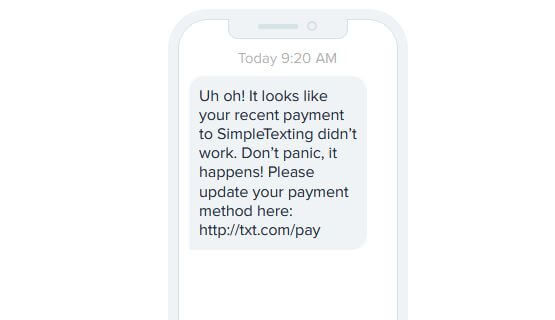
Source: simpletexting
Or you can try with something more formal and direct, like the following example:
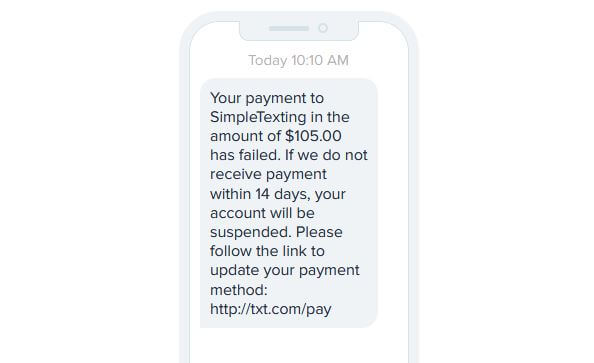 Source: simpletexting
Source: simpletexting
Whatever you choose, include the essential information. The whole point is that a customer is informed about her payment’s failure, where the money was supposed to go, and how to proceed.
Including a link to a method of updating payment information is very helpful as well. Speaking of included links, let’s talk about how you can create an effective call to action for your embedded link.
Create an Effective Call to Action
As you’re sending your message about payment failure to the customer, remember to make their next steps super clear. A good way to do that is to add a call to action (CTA).
A call to action simply means informing your customer, in a clear and concise way, what to do next regarding the failed payment.
The reason is obvious—you want the issue resolved as efficiently and quickly as possible while still giving customers a seamless and stress-free experience. It’s good for you as a provider and good for them as users.
An effective CTA is clear and straightforward. You can make it that way in different ways, but the customer should never doubt how to proceed, where to click, or what’s going to happen next.
Some companies opt for a CTA in the form of a big, clickable button. It is a good idea to keep the text on the button short and large enough to read, but not so large it is threatening.
Also, make it pop; use bright colors to make the button stand out from the rest of the message.
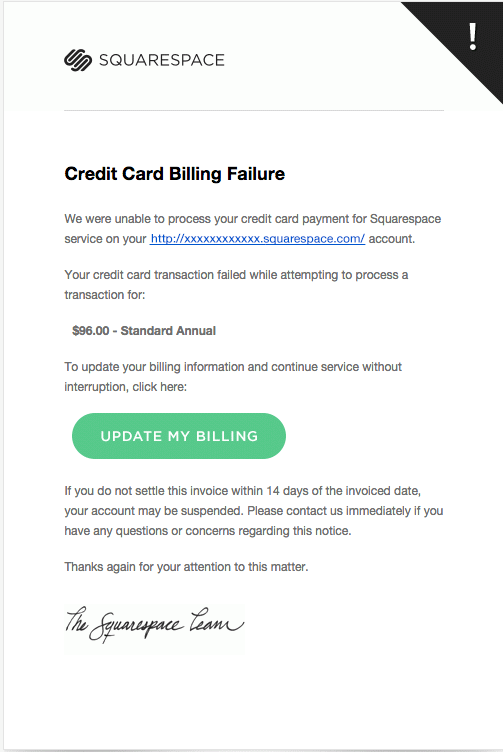
Source: ltvplus
In this example from Squarespace, notice the wording; they used “my” instead of “your” when talking about the billing. That is hardly an accident.
At Unbounce, they tested the difference, and it turned out that using “my” is 90% more effective. In other words, a lot more people clicked on it.
You don’t necessarily have to use a button in a CTA, either. Amazon doesn’t; instead, they have step-by-step instructions for the customer.
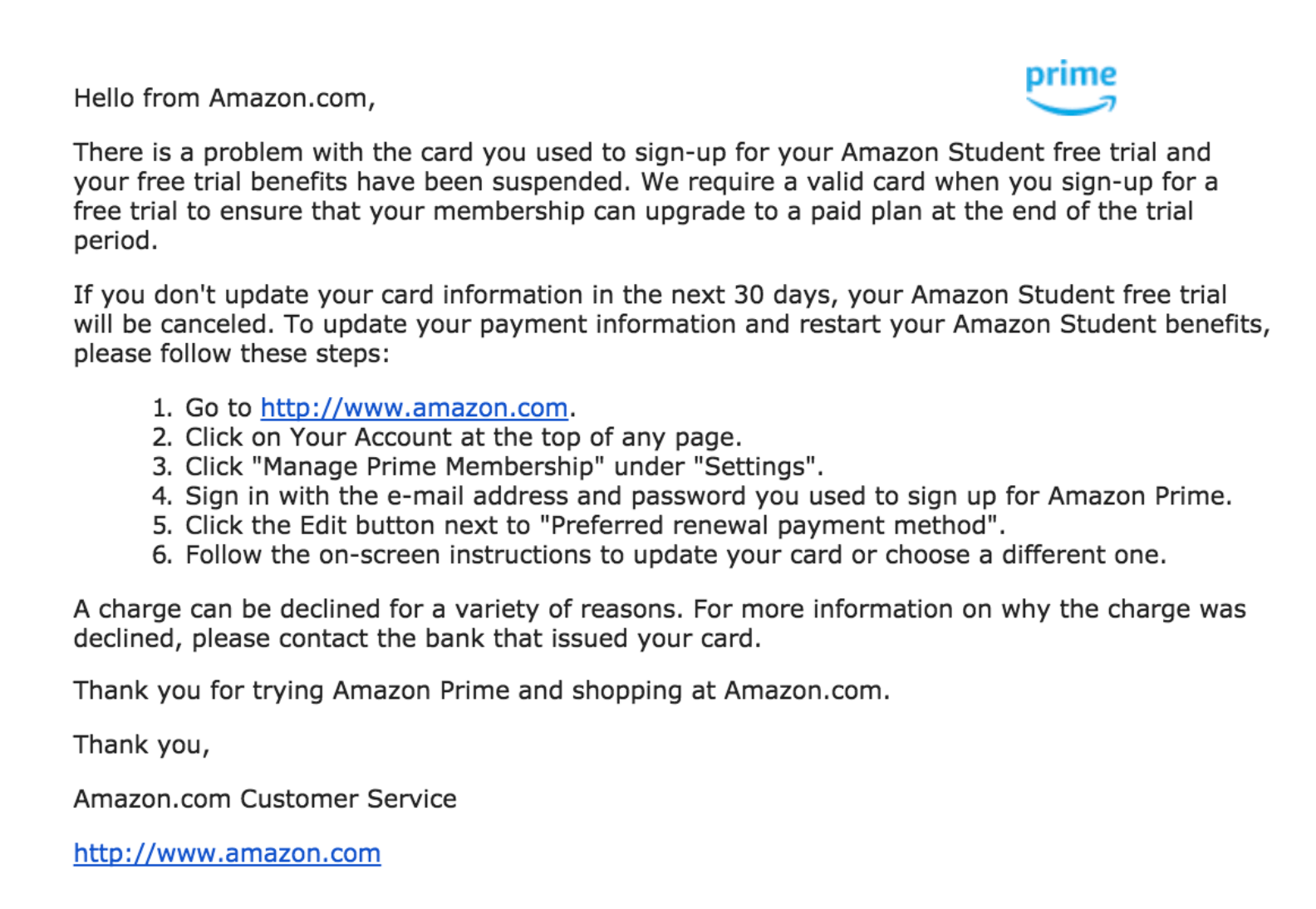
Source: ltvplus
There is a lot of text, but everything is still clear, and the customer knows how to proceed.
Still, it’s advisable to opt for the button rather than a link, simply because it’s more customer-friendly. At Campaign Monitor, they tested what gets more clicks, and using the button in the CTA increased the click-through rate by 28% compared to a link.
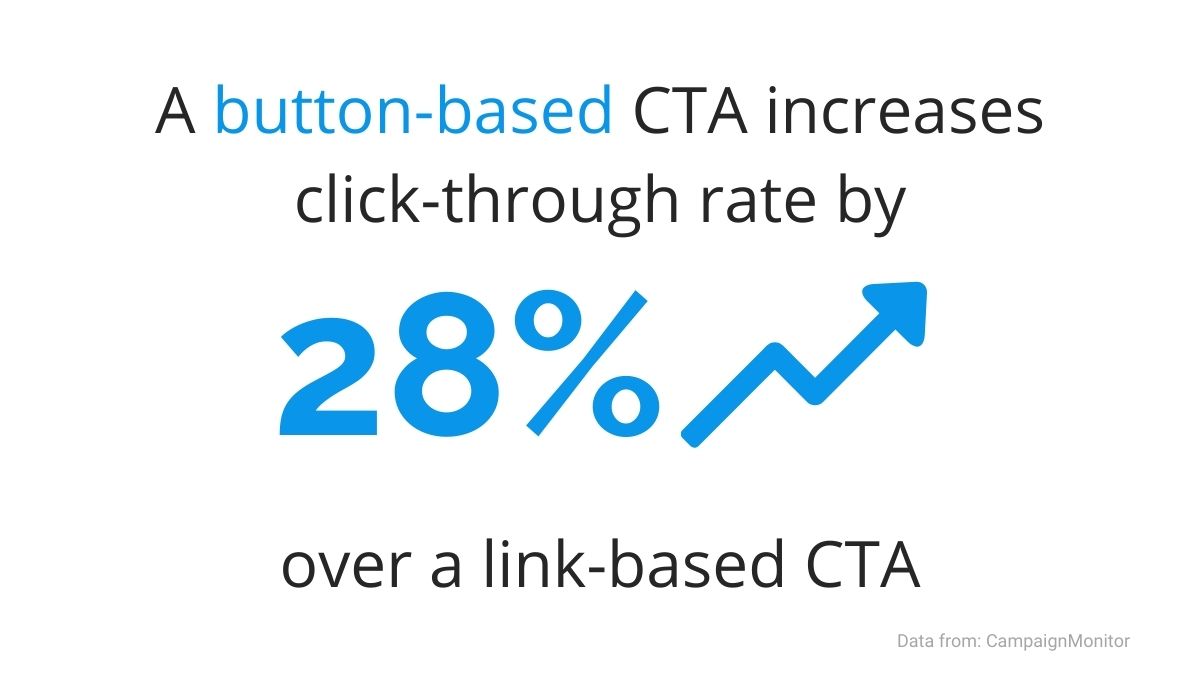
Source: Regpack
Another reason is a better mobile experience. Imagine trying to follow those Amazon instructions and switching between multiple tabs on your smartphone to read what to do next.
A link and a set of instructions will get you there eventually, but a simple button that lands you on the exact page where you can update your information is certainly less labor-intensive.
Sure, when you are on a desktop computer, it makes little difference, but keep in mind that we all use our mobile devices more than our computers to navigate the internet these days.
And once you’ve created an effective CTA and made life easier for your customers, why not use automation to make it easier for yourself?
Automate Your Dunning Emails
By automating your dunning emails, you can save yourself a lot of trouble, as well as a considerable amount of time.
Let’s keep in mind one universal truth—people make mistakes. We make them, you make them, people who manually write dunning emails certainly make them.
When you manually write, send, and manage reminders about payment failures, you waste valuable time and resources that you could invest in something more worthwhile.
Not to mention typos, sending reminders to the wrong person, double-invoicing, or simply forgetting to send a message at all. All of that can happen, and it does not convey a professional image by any means.
A good solution can be billing software that can automate a lot of that and more.
For example, Regpack, among its many solutions, offers managing communication with your customers with email templates that you can tweak and adjust according to your needs.
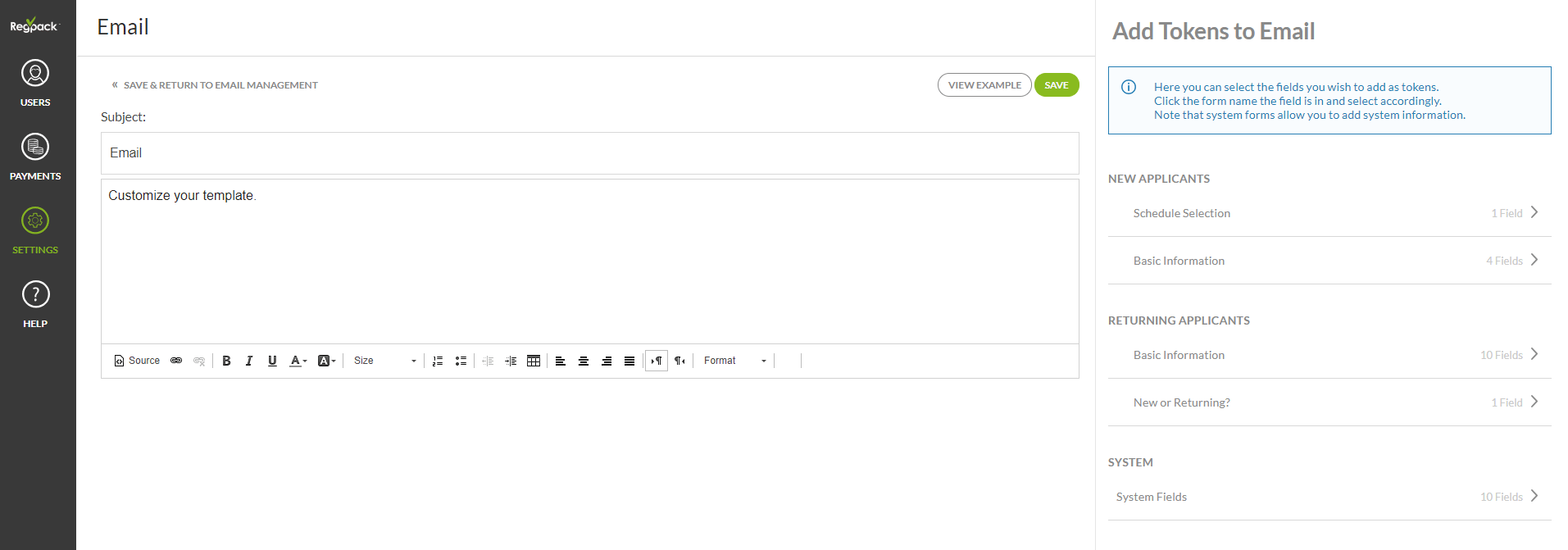
Source: Regpack
You can still personalize the dunning emails sent like this if you want. Solutions like Regpack have many customizing options and filters so every customer can receive exactly what they need.
For example, you can set your billing software to trigger an email that will warn the customer their payment has failed. That way, the customer knows almost instantly that there is an issue and can react accordingly.
That means you can automatically send a larger number of emails at the same time, safe in the knowledge that every message contains the right content and is sent to the right recipient at the right time, eliminating a lot of the errors that are made when these types of emails are sent manually.
Of course, the possibilities don’t stop at automating dunning emails. The automated billing feature is another helpful tool that makes collecting payments a breeze.
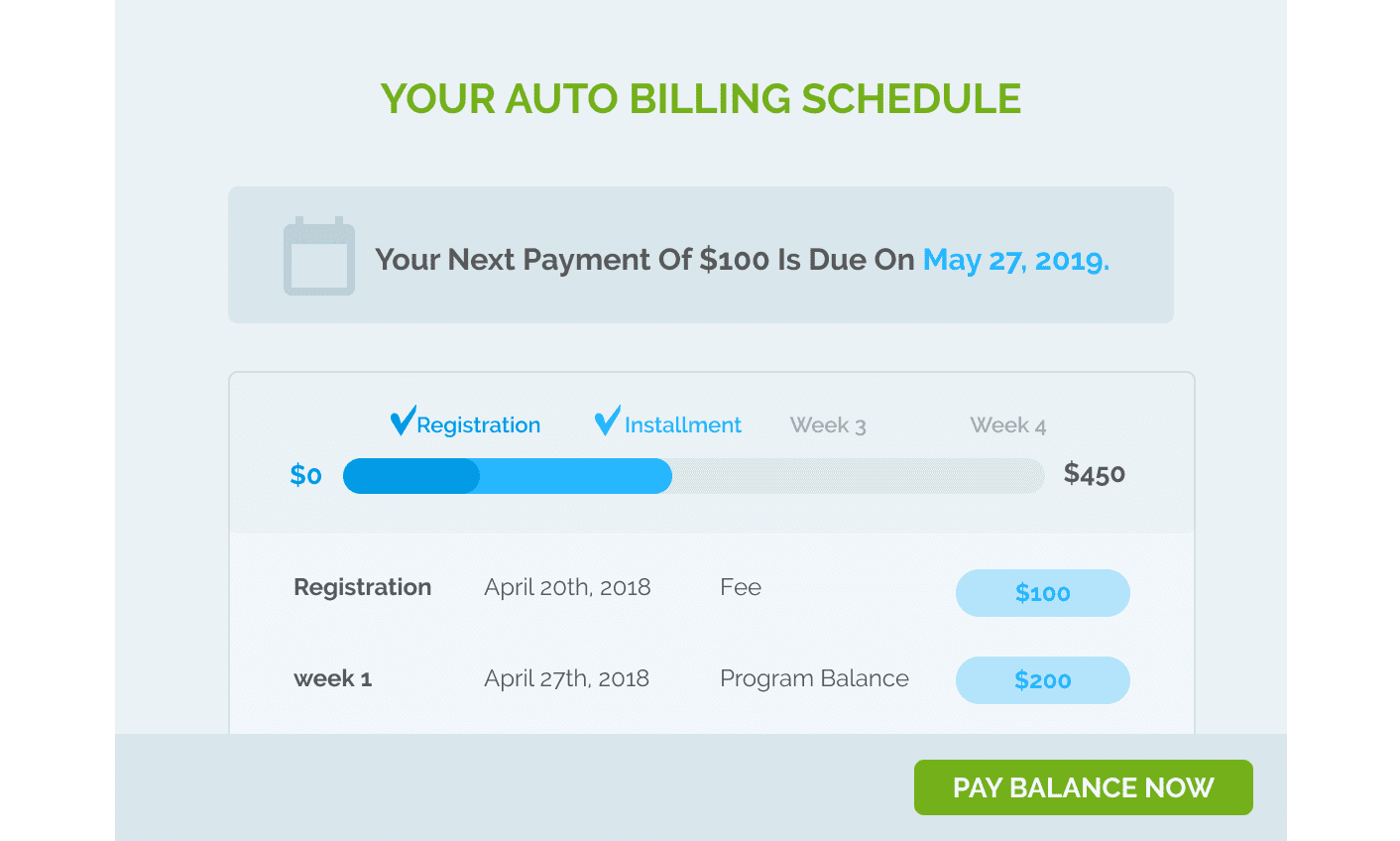
Source: Regpack
Just schedule the billing dates as needed and set the desired amounts your customers should be paying.
With your parameters set, you can focus on other tasks, knowing that the responsibility of timely and accurate billing is handled by your billing software.
Automation is becoming a core staple of modern-day business. Therefore, invest in the right software that will suit your needs to make sure your billing is done on time and has less chance of failing.
Conclusion
Managing payment failure can be delicate and tricky. You don’t want to anger, embarrass or alienate your customers, but you still want your money.
That is a tight rope to balance, but it can be done, as we’ve shown throughout this article.
Preventing payment failure, retrying if it still happens, properly communicating the issue to your customer, wisely choosing the communication channel, creating a good CTA, and using automation software like Regpack can go a long way.
Using the tips from this article will make managing payment failure something that is just a footnote in your business – like it should be.


















